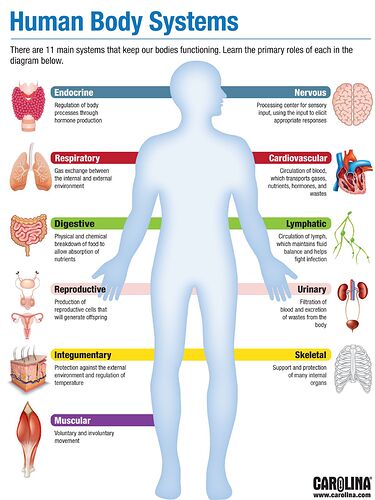Hey there
I am using this space to think out loud and to fish for more information/ideas/leads from people. Because I’m sure I am not the first person to think about all this - so give me a moment to reinvent the wheel, alright?, and then I want to hear who has already figured this out!
So if we try to learn from what a human body as a complex system does, does that help us understand organizations better to learn what functions are needed in an organization? I’m looking at it through a sociocratic lense but of course it’s universal. In particular, I am curious about this comparison as a trainer and consultant so I want to find a comparison that makes sense so I can use it as a shortcut to explain sociocracy.
Here we go.
- A human body has a basic system of bones and muscles (skeletal and muscular). That’s like domains and aims. In an organization, those are more fluid than in a body where they are somewhat immutable. You can’t just take off an arm and put it elsewhere but you can do that with a circle. And domains and aims can change over time. They can also grow in terms of activity, like a muscle grows when we use it more often.
- The nervous system is the information flow in an organization. I’m not understanding the nervous system in our body enough to say more about this. In particular, I’m curious how the decision to move your arm is made in our body and how the nervous system and muscles work together. But maybe that’s going too deep into biology that’s really irrelevant here.
- Respiratory, digestive and urinary system are the different revenue streams of an organization, a complex nutrients-intake system.
- The cardiovascular system provides all the parts with energy, so it’s the counterpart of budget allocation. Different parts get more or fewer resources under different conditions.
- Lymphatic system and immune system. - I know way too little about these systems but from what I understand in my reading, this might equate to conflict and maintenance of records etc. Keeping the system clean and smooth, as well as taking out “obstacles” in the system. I tend to see conflict as an outside interference because people often get into conflict because of something unrelated to the organization (past or present). So it shows up as a tension inside of the organization but it’s not really inside the organization.
- Integumentary system (skin, temperature, etc.). Builds a membrane between inside and outside. Maybe that relates to membership in an organization? Hm… also includes the legal manifestation of an organization. Not sure about this one.
- Endocrine system (hormones etc.) - I find this one the most fascinating. I know hormones are complex because of the interplay of so many sources of hormones and how receptors receive them. Strategy is exactly like that. Looking at a simple example, if we’re scared and go into fight-or-flight, our hormones will slow down certain functions (like the digestive system). In the presence of certain hormones, each part of our body does its own thing in reaction. In the same way, strategy works in a decentralized organization. Let’s say a pandemic hits, each part of the organization now figures out what that means to their particular piece. Do we need to ramp up our systems or slow them down? Do something different or all the same? It’s also similar in how hard it is to understand strategy in a decentralized context, and as far as I know, the complex interdependence of hormones makes them really hard to understand as well. So that’s an area to think about more, in particular because, in our body, we see “strategy” at work with heavy interdependence but no coercive power.
- (Reproductive system - not something I am focusing on right now though there are interesting things to say/think about it in the context of organizations. For example, how many organizations are “born” as spin-offs, and how hard it is to build an organization without an externally sourced DNA - see my book Who Decides Who Decides).
That means we come out with things every organization needs:
- basic structure of domains; aims connected to it so work can happen in each unit
- flow of information between units (linking and other, like this forum!)
- influx of revenue
- internal budget allocation
- conflict resolution
- overall systems maintenance (log keeping, membership services)
- defined membership
- legal/institutional membrane and protection
- strategy for prioritization
Let me reiterate that I’m not interested in reinventing the wheel here. I just want to know
(1) where I can read more about these thoughts
(2) whether this makes sense to you? Do you think it’s useful to explain sociocracy with this analogy?
Would love to hear as many reactions as possible but I’ll tag @rhonda.baird @shala.massey @andreas.jonsson @phouben @jerry.koch-gonzalez @egon.loke @graham.boyd
